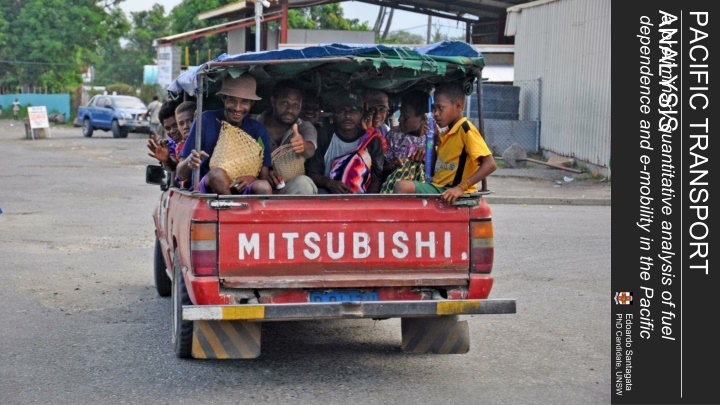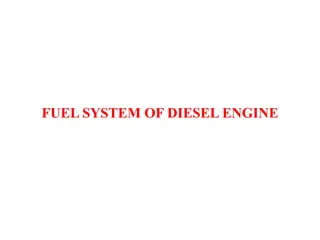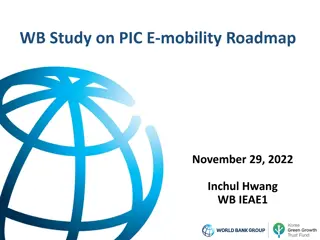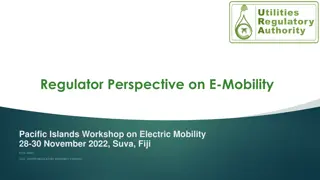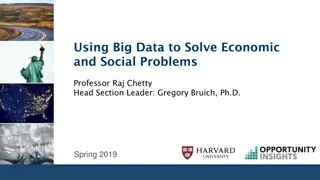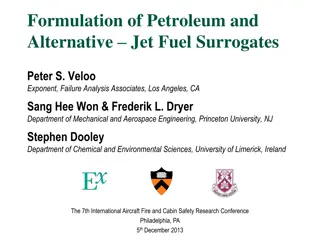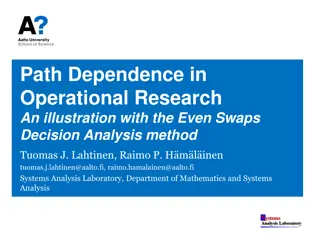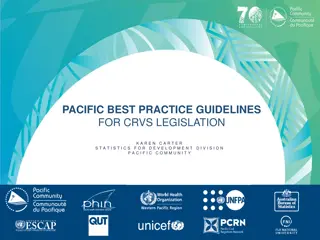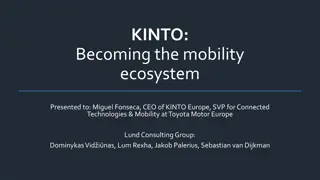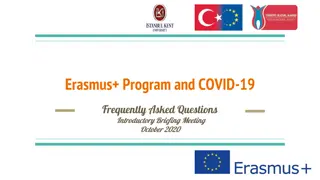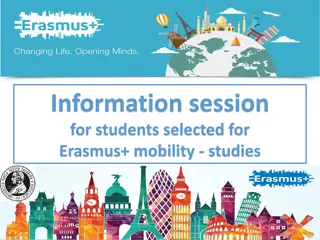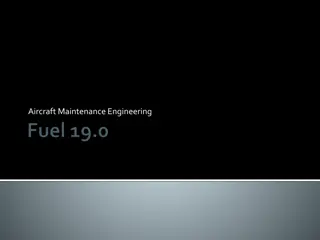Preliminary Analysis of Fuel Dependence and E-Mobility in the Pacific
This study by PhD Candidate Edoardo Santagata at UNSW delves into the fuel dependence and potential for e-mobility in the Pacific region. It includes data collection on energy consumption, fuel demand, vehicle registrations, and scenarios for electric vehicle integration. Preliminary findings highlight the extent of fuel consumption and import expenditure, shedding light on the current state of urban transport fuel consumption.
Download Presentation

Please find below an Image/Link to download the presentation.
The content on the website is provided AS IS for your information and personal use only. It may not be sold, licensed, or shared on other websites without obtaining consent from the author.If you encounter any issues during the download, it is possible that the publisher has removed the file from their server.
You are allowed to download the files provided on this website for personal or commercial use, subject to the condition that they are used lawfully. All files are the property of their respective owners.
The content on the website is provided AS IS for your information and personal use only. It may not be sold, licensed, or shared on other websites without obtaining consent from the author.
E N D
Presentation Transcript
ANALYSIS PACIFIC TRANSPORT dependence and e-mobility in the Pacific a preliminary quantitative analysis of fuel PhD Candidate, UNSW Edoardo Santagata
CONTENTS 1. Data Collection 2. Preliminary Findings 3. Scenarios of EV Integration 4. Limitations 1
DATA COLLECTION Undertaking construction of comprehensive database for 19 PICTs I. General Demographics & Economic Indicators II. Energy Capacity & Mix + Operational Factors (Peak, Losses, Tariffs) III. Total Energy/Electricity Consumption per sector (Transport, Manufacturing, Construction, Mining, Agriculture, Forestry, Fishing, Commerce, Public Services, Households, Other) IV. Fuel Demand & Energy Balances (Imports, Exports, Transformations, Stock Changes, Biofuel Primary Production, Other Primary Production) V. Vehicle Registrations per type & Patterns of use (Annual Distance, Fuel Efficiency) Estimate of Required Energy & Capacity, Fuel Import Reduction, Emissions Reductions for electrification of urban vehicle fleet 2
PRELIMINARY FINDINGS What does this fuel dependence look like? 3
Fuel Consumption (%total energy consumption) 100.00% 90.00% 80.00% 70.00% 60.00% 50.00% 40.00% 30.00% 20.00% 10.00% 0.00% Micronesia Tonga Cook Islands Nauru French Polynesia Fiji Niue Vanuatu Tuvalu Samoa New Caledonia Kiribati Solomon Islands Papua New Guinea 4
Import Expenditure (%imported) Micronesia Niue Vanuatu Papua New Guinea Kiribati Cook Islands Samoa New Caledonia Tuvalu Palau Solomon Islands Tonga Fiji American Samoa Nauru Guam 0.000% 10.000% 20.000% 30.000% 40.000% 50.000% 60.000% 70.000% Refined Petroleum for Urban Transport (%) Refined Petroleum for Electricity (%) Refined Petroleum for Other Purposes (%) Refined Petroleum - unspecified breakdown (%) Petroleum Gas (%) Cars (%) Buses (%) Trucks (%) 5 Motorcycles (%) Bicycles (%)
Urban Transport Fuel Consumption (%fuel supply) 70.00% 60.00% 50.00% 40.00% 30.00% 20.00% 10.00% 0.00% Vanuatu Solomon Islands Samoa Niue Fiji Tonga Kiribati Nauru Papua New Guinea New Caledonia French Polynesia Palau Tuvalu Micronesia 6
Fuel Conversions to EV Data from ADB Sustainable Development Working Paper Series E-mobility options for ADB developing member countries + Tesla (40t truck) ICE EV @ 3.5 kWh/L Running 100% on Diesel Genset 0.4 0.4 0.35 0.35 0.3 0.3 0.25 0.25 L/KM L/KM 0.2 0.2 0.15 0.15 0.1 0.1 0.05 0.05 0 0 Fuel Consumption reduction even with diesel power generation! 60% 50% 40% 30% 20% EVs are worth it regardless of generation mix 10% 0% 8m bus 10-12m bus microbus 3.5-7t truck 40t truck rickshaw motor cycle passenger taxi 7 car
SCENARIOS of EV Integration 3 scenarios of EV Uptake: 100% EV, 50-50, 25% EV 3 scenarios of Generation Mix: 100% RE, 50-50, 100% Diesel Fuel Price of 1.22 $/L Fiji Vehicle Fleet Composition + statistical adjustment to match energy balance 8
Required electricity as % of current 140.00% 120.00% 100.00% 80.00% 60.00% 40.00% 20.00% 0.00% Fiji Marshall Islands Samoa Nauru Vanuatu Palau Kiribati Cook Islands Solomon Islands Tonga New American Samoa French Polynesia Micronesia Niue Tuvalu Northern Mariana Islands Papua New Guinea Guam Caledonia Scenario 1-3 Scenario 4-6 Scenario 7-9 9
Fuel Import Reductions (L) 700000000 600000000 500000000 400000000 300000000 200000000 100000000 0 Fiji Marshall Islands Samoa Nauru Vanuatu Palau Kiribati Cook Islands Solomon Islands Tonga New American Samoa French Polynesia Micronesia Niue Tuvalu Northern Mariana Islands Papua New Guinea Guam Caledonia Scenario 1 Scenario 2 Scenario 3 Scenario 4 Scenario 5 Scenario 6 Scenario 7 Scenario 8 Scenario 9 10
Fuel Import Reduction as % of GDP 14.00% 12.00% 10.00% 8.00% 6.00% 4.00% 2.00% 0.00% Fiji Marshall Islands Samoa Nauru Vanuatu Palau Kiribati Cook Islands Solomon Islands Tonga New American Samoa French Polynesia Micronesia Niue Tuvalu Northern Mariana Islands Papua New Guinea Guam Caledonia Scenario 1 Scenario 2 Scenario 3 Scenario 4 Scenario 5 Scenario 6 Scenario 7 Scenario 8 Scenario 9 11
Fuel Import Reductionas % of imports 25.00% 20.00% 15.00% 10.00% 5.00% 0.00% Fiji Marshall Islands Samoa Nauru Vanuatu Palau Kiribati Cook Islands Solomon Islands Tonga New American Samoa French Polynesia Micronesia Niue Tuvalu Northern Mariana Islands Papua New Guinea Guam Caledonia Scenario 1 Scenario 2 Scenario 3 Scenario 4 Scenario 5 Scenario 6 Scenario 7 Scenario 8 Scenario 9 12
Emissions reductions as % of current 80.00% 70.00% 60.00% 50.00% 40.00% 30.00% 20.00% 10.00% 0.00% Fiji Marshall Islands Samoa Nauru Vanuatu Palau Kiribati Cook Islands Solomon Islands Tonga New American Samoa French Polynesia Micronesia Niue Tuvalu Northern Mariana Islands Papua New Guinea Guam Caledonia Scenario 1 Scenario 2 Scenario 3 Scenario 4 Scenario 5 Scenario 6 Scenario 7 Scenario 8 Scenario 9 13
Added capacity does not include infrastructure updates, energy delivered, and complementary services Lack of capacity expansion model estimating capacity simply is reliant on assumption that load profile does not change (false) No scaling of annual distances for road network size No difference in electricity output per composition mix Based on estimates regarding vehicle fleet sizes and vehicle fleet composition (mirroring Fiji s situation) + manual adjustment Old vs new vehicles - generalised vehicle properties may not account for degradation in efficiency (ADB figures are for new vehicles) Types of vehicles considered are country-dependent and future uptake is varying Cost of EV integration not included to offset fuel import reduction Informal vehicles are present and not accounted for System level vs local level: accuracy in detail of potential network and vehicle fleet distribution Increase in peak demand not accounted for in scaling Database rigor, age, mismatches, and absence Limitations 14
ACKNOWLEDGEMENTS Iain MacGill Atul Raturi Abraham Simpson The University of New South Wales University of the South Pacific Freelance Consultant 15
Thank you! Merci! Faafetai! Tenkyu! Tubwa! Tangkiu! Malo! Kom m ool! Whakawhetai ki a koe! Fakafetai f fetai! Si Yu'os Ma' se ! Edoardo Santagata edoardo.santagata@unsw.edu.au
